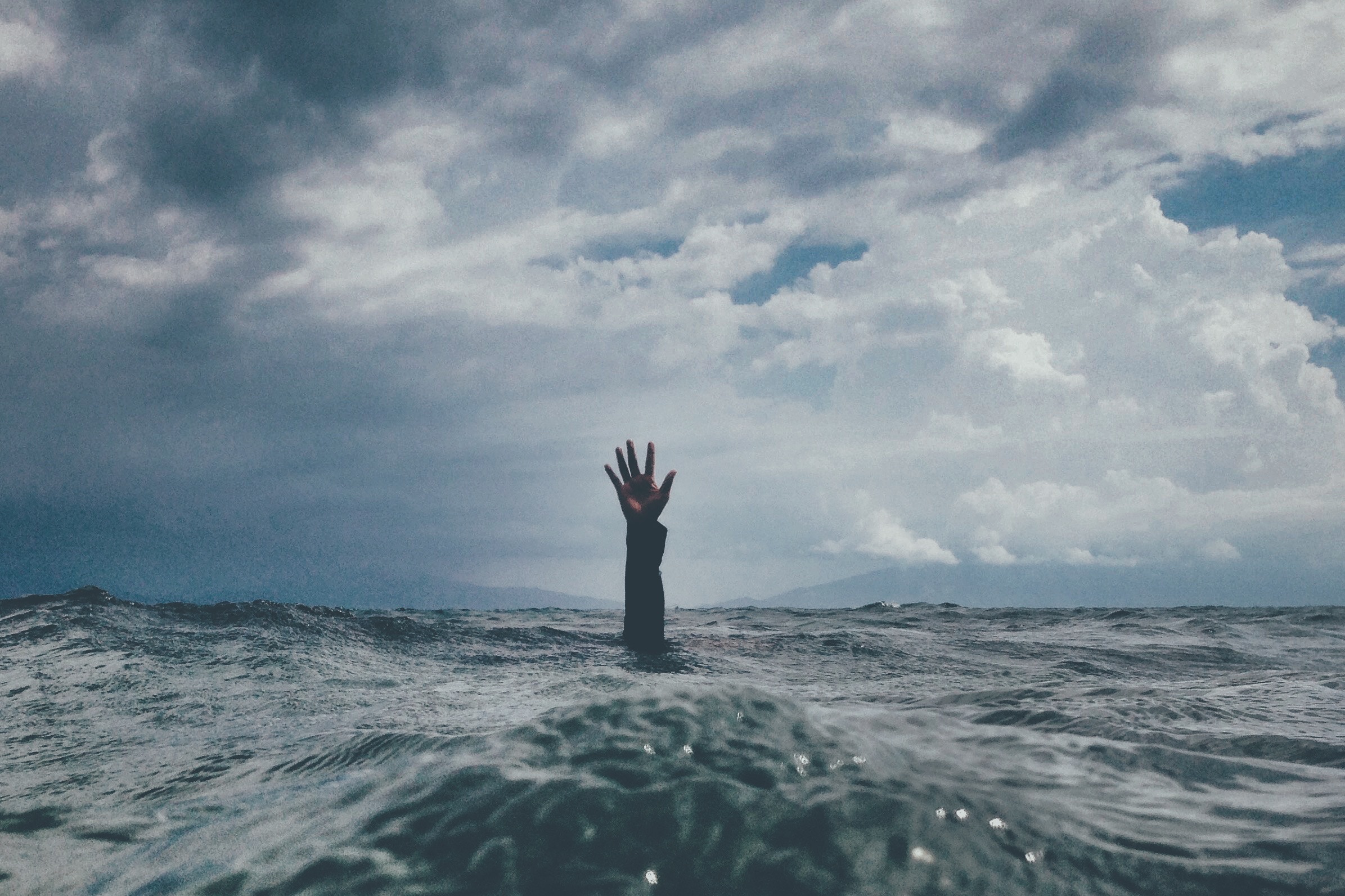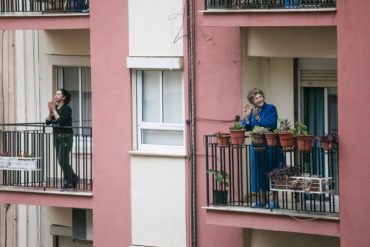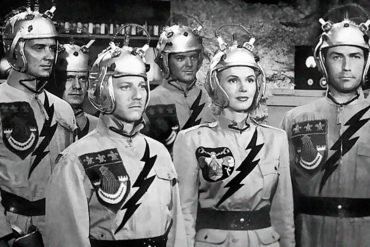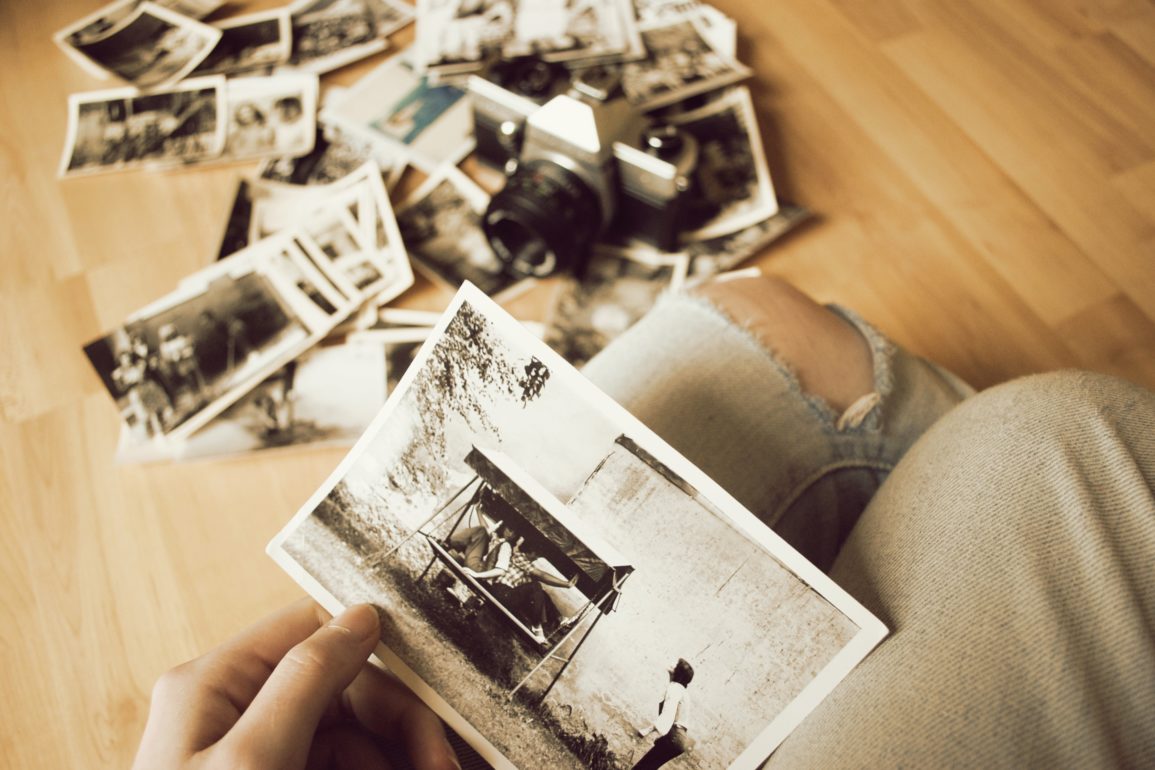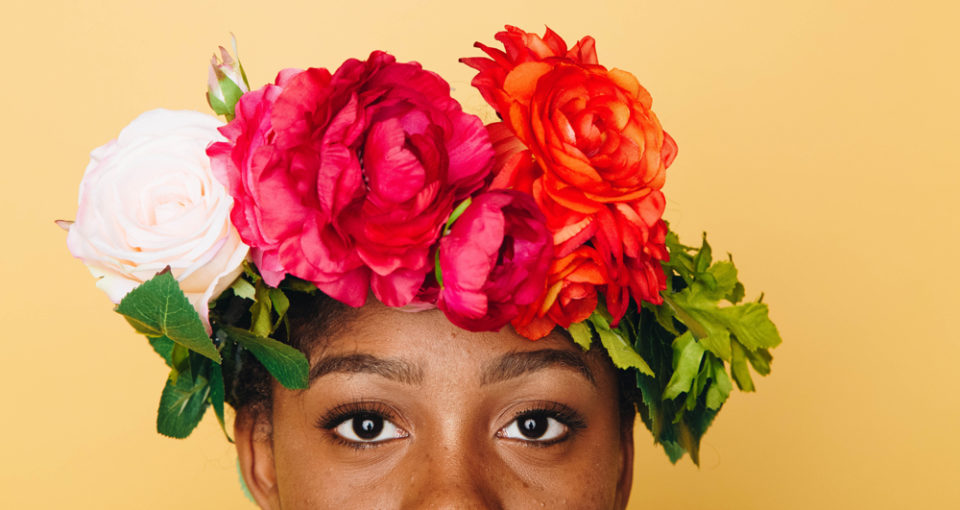“I got my photo album from my bedroom. It was full of all the images I never wanted to remember but carried around with me so I’d never forget. ‘A poem is a record of change,’ Mr. Basketball said once, and this felt true to me; I was a record of change, and this photo album was a record of change. My father and Mrs. Resnick in the woods at his birthday party. Mr. Basketball’s red gym shorts, my mother on the couch holding a martini. I put the picture of the bench with the word ‘rain’ in an envelope and sent it to Mr. Basketball. I didn’t know why exactly, or if he even had the same address, or if I was just sending something out there to the universe, but it seemed to me that he was the only person who would understand exactly what I saw in all of this.”
Alison Espach, The Adults, p. 187 (2011)
Holding On to Images
My mother is superstitious about throwing away photographs, even the ugly ones. It feels too much like throwing someone away, she says. And now that I think of it, I cannot shake from my mind the image of a photograph in the garbage, haunting me, pleading to be remembered, if only to be re-forgotten, and so on. This must be how hoarding begins. When every artifact reminds you of a face, however foreign and faded, you must keep these things alive. Or at least freeze-dried, buried in Rubbermaid fire-proof bins, so that we feel prepared.
Once you’ve captured a face – even a squinting-in-the-sun face, or an unflattering-chin-angle face, or even a face you no longer know – you cannot let it go. You made a commitment, and you must handle the shiny paper carefully, by the edges, so as not to smudge the ink. So as not to tamper with the evidence.
Glossy photo paper does not bend easily. One gets the sense it could withstand a trip to the landfill and rise to the top of the heap, find its way through the wind to land on a random sidewalk on the way to 7-11, to be found by a young girl who believes herself to be uniquely sentimental.
No one can remember the name of the babysitter in the corner or recognize the friend featured on the bench. Strangers pose in cameo roles throughout our still images; they could be anyone.
I can’t remember whose dog I was holding, or recall why I was throwing a temper tantrum by the pool. I know what I see, except not really; I imbue these scenes with my own interpretations. I don’t mean to; it’s not my fault. It’s just that I need things to come back to, to remind me of the things I have a hard time believing I ever was. I need these images to prove me wrong. See?! I assert to myself, indignant. You were like this all along.
Now You Are So-and-So
How bound am I to the images of myself that bear witness to my once-rosier cheeks and still-chubby thighs, to the friendships I was born into? I am crouching in the grass, with a cluster of other kids; my bangs stick to my forehead and I am wearing a loud romper, bold yellow and pink stripes, with a polo collar. We are gathered around a heaping basket of apples we had collected at the orchard. So-and-So’s mother told her it’s okay to wash an apple by just rubbing it on your shirt after you pick it, so it must be true.
That’s So-and-So, my childhood best friend. I narrate the photograph, editing the caption. The back is marked “1999.” I make something up when my Bubbie asks what So-and-So is up to these days.
We were friends because we were in each other’s childhood photo albums, and then because we had called each other “sister” enough times that it felt indissoluble at a certain point. Because we still laughed at the photograph of us in our elementary school uniforms eating spaghetti with tomato sauce and butter. We had these things to come back to, as if to say: See! You are still here, still you, craving the same pasta. Remember when you used to sing along to that song from the 90’s that listed all those women’s names? You can still be friends. This can be enough, I swear. No-fault divorces are harder to come by in friendships; you must answer to the photographs, explain to your own faces why those scenes must be relegated to history, instead of attesting to the truths of now. It’s our fault for disappointing our own past images.
The worst part of endings is giving up on the photographs. When there were such good moments. And what does one do with those albums? Discarding them would trigger paranoia, lest some unknown disaster occur to the photograph’s subject, leaving me to assume some level of metaphysical guilt for throwing away a person. Anyway, I hope she’s doing all right.
We held on for a good while; most of my breakups have gone this way. We gave it every shot we could, if only to validate the photographs and their promises of things one day making sense again. If not for the apple orchard, then for the mirror selfies and birthday collages. For the pictures of me and some boy or another – on rickety swings, or napping under a tree; licking ice cream cones, or wearing matching aprons; jumping in a spring, or drinking whiskey sours. There was too much to just throw away. Look, say the images. Don’t you see all that you could be?
Sacred Sentiments
“Meaning is a shaky edifice we build out of scraps, dogmas, childhood injuries, newspaper articles, chance remarks, old films, small victories, people hated, people loved; perhaps it is because of our sense of what is the case is constructed from such inadequate materials that we defend it so fiercely”
Salman Rushdie
I keep a One-Line-A-Day notebook where I write a few things I am grateful for every day; the best part is that my current notebook is a “five-year memory book,” so most nights, as I record the big and small joys of my day, I also look back at the last two years, comparing notes, as if lining up the edges of present and past to measure their relative dimensions. Some highlights (random sample) include:
- “Flirting with _____”
- “good oatmeal”
- “finishing my senior thesis!”
- “re-reading Invisible Man”
- “BYOC day at 7-11!”
- “laughing with _____ and ______”
- “turkey”
- “writing at Hungarian Pastry Shop”
- “good focus in shiur”
- “Israeli MTV”
I find myself seeping with sentimentality, fastidiously marking firsts and lasts, commemorating anniversaries of dinners eaten, dresses purchased, conversations had. The thing is, it’s not that I necessarily ascribe any significant meaning to most of these; I am searching for a word to convey a certain sense of endearment with objects of the past, an affection for the things that anchor us in our memories, connect us to the selves we resemble through these details, even through our layers, our wrinkled skin.
I have come to find it important to be able to look at myself with admiration, in the way one might fixate tenderly on a lover’s dimple. I find pleasure, however vain, in revisiting my old notebooks; not even to read the passages, so much as appreciate the aesthetic of the pages, marked with scrawled ribbon-like doodles, bubble-lettered words like “enigma” or “abundance” or “calendar.” The lines are covered in my handwriting, illegible but somehow endearing to me, if only for its distinctiveness. The problem is I don’t pick up my pen enough, instead connecting every letter with inky trails. I can make it look neater if I need to, but my natural scrawl is what I find most compelling. It’s so me. As if there might be something reassuring in the possibility of being reduced to those looping, lingering lines. Some things never fade, like birthmarks that stay permanently etched into your skin, regardless of the rest of the body’s growth. My handwriting matches up to the way it looked years ago; the evidence corroborates that I am indeed myself, and have been all along.
I Keep Coming Back
Every year, usually toward the onset of summer, I re-read my favorite novel, The Adults by Alison Espach. When asked to explain what makes this book my favorite, I get stuck at “it’s just really good!” For now, just take my word for it.
Aside from the book itself, the experience of re-encountering these words and this story is a sort of check-up for me, to make sure I still know myself, and to make sure things are as good as I remembered them. Each year, I am pleasantly surprised again; my taste is trustworthy, at least by my own standards, and as demonstrated by sheer consistency.
I take solace in favorites, in the way my mom always made tuna-noodle casserole for dinner when I came home from camp. I am thankful to this novel in the way I extend gratitude to that one polyester blue dress I have had for years, the one that never lets me down; thank you, to the colorful details, the clutter on my desk, the amalgam of images that form a collage that may one day be altered; but there will always be things to come back to.
Thank you, to the things that often are even better than I had recalled. Thank you, to the things I can always come back to, to remind myself that my past and present selves are one. In fact, they overlap and dance together, intertwining until the distinctions and divisions between them are mostly dissolved. I read the present into my memories; they take on lives of their own.
I Used to Be Confused
There is a photograph of me at age four or five, leaning on my dad’s grave, completely oblivious to context. I love it, but I don’t show it to a lot of people because it’s the type of image that, not unlike talking about death in general, and my dad’s specifically, makes people uncomfortable. People don’t know how to react when you present feelings they don’t understand, when they can’t mirror your facial expressions, because you’re smiling and calm, and they don’t have the license to also, or because you’re in pain and they are too, but only because you are, and they don’t want to make you uncomfortable, but the awkwardness is unavoidable.
My hair is a little brighter red than it is now, in a bowl haircut framing my tiny face. I am wearing the frilly socks I always hated- too fussy. I am holding dandelions I picked from the cemetery; when I visited a few months ago, I noticed the grass is now wild and overgrown around the gravestone, even though we paid for “perpetual care.”
In this photograph, I am smiling, though I am clearly aware that I am “supposed to” be experiencing pain. I am doing the best imitation of anguish that I can muster, modeled after the adults who have been Doing Their Best these days. It is this precise facial expression I struggle to remember, checking the photograph to confirm its actual appearance. When I look away from it for even a minute, I find I need to glimpse back at it again, at that strained little face, lest I remember it inaccurately. In fact, sometimes when I try to summon the image to mind, that face blurs away, like the pixelated faces of anonymous people on television. It does not stick with me, but only flickers in my mind’s eye, refusing to establish itself in certainty or high-definition.
I try not to read too much into the small details, like the bunch of dandelions I picked from the cemetery and am squeezing ruthlessly in my hand; I resist the urge to wax poetic about these weeds and their allusions to life and death and transience, because most likely, they were just yellow flowers to me, picked mindlessly from the cemetery green. I look one more time at that contorted face, determined to capture it finally. Perhaps I’m looking too closely to see anything at all.
Like Looking Through A Fogged Mirror
“‘Suppose yourself in a large cinema, sitting at first in the back row, and gradually moving up…until your nose is almost pressed against the screen. Gradually the stars’ faces dissolve into dancing grain; tiny details assume grotesque proportions;…it becomes clear that the illusion itself is reality.’”
Salman Rushdie
As I look at it once more now- probably for at least the thousandth time, but then again, perhaps it’s the thousandth-and-first – I notice with surprise the untouched green grass in the background, sprawling behind me and my dad’s burial site. I guess I had just been transposing my more recent memories of the place – now, new gravestones cover that previously unadorned grass- and had not noticed this element, this emptiness. I guess I hadn’t really been seeing, that I had been doing the equivalent of “listening” to another person while simultaneously considering my next remarks, not engaging with the process of assimilating past and present images. I had too soon “updated” my mental image to reflect the current landscape, without honoring what was.
I wonder if this is a key difference between “looking” and “seeing”, the former involving the imposition of assumptions, the knowing or unknowing donning of lenses, a degree of direction already guiding me toward a destination or schema. I guess sometimes I need to squint to really see, narrowing my focus to avoid those obtrusive lenses and just notice the scene before me.
Maybe it’s just easier to read the present back into the past, rather than consider the weight of those days in the nineties as they mark me now, like stubborn purple lipstick stuck on my cheek from my grandmother’s affection, or like a ruthless bruise. I was a little girl in an itchy green cardigan, and the grass was not sprinkled with dead people’s names. I do not know how to reconcile these changes, the “before” and “after” bearing uncomfortable likeness to one another, though not on the surface. The grass is more sparse now than it was fifteen years ago, and I am taller and even more curious. But in a way, I might still be contorting my face like that, totally uncertain how to relate to my own DNA. I still have little to no idea what I am looking at, or looking for.
I wonder, looking at that empty lawn, captured by a disposable Kodak, how this could have escaped me, how I could have forgotten how empty it used to be there. How I must have never stopped to consider another possibility. How I remembered the dandelions and not the grass, some “remains” more reachable than others. Does this detail of the cemetery lawn radically shift my self-understanding, my relationship with death, my overall quality of life? Not even slightly. But it does feel valuable in some unnamed way, I suppose, to consider how so many things go unnoticed in the glitter-dust of memory, the blurred negatives of photographs.
I Almost Remember
I remember this photograph from time to time, indicating it must mean something to me. I look at it and feel stunned by the rawness captured for posterity. I do not know what to make of this moment having been documented at all. Kids are so unaware of their own presence, the ways they take up space. They do not share the kinds of insecurity that nag at adolescents -and adults too- that constantly make you wonder if you’re accidentally giving someone the wrong facial expression (God forbid it be the infamous “resting bitch face”). I feel invasive to an extent, witnessing my own moment of totally innocent ignorance, clueless to the gravity of this place or the place it would continue- whether I liked it or not- to have in my life.
I can’t stop looking back at my small, squinty face, totally confused. That face expresses something I couldn’t explain to you without you seeing it yourself. I try to give it another glance, determined to record it precisely this time. I try to drop all my presumptions and just stare that little girl in the face. I can never quite remember that face until I look at it again, anew. And then I look away and forget all over again.

